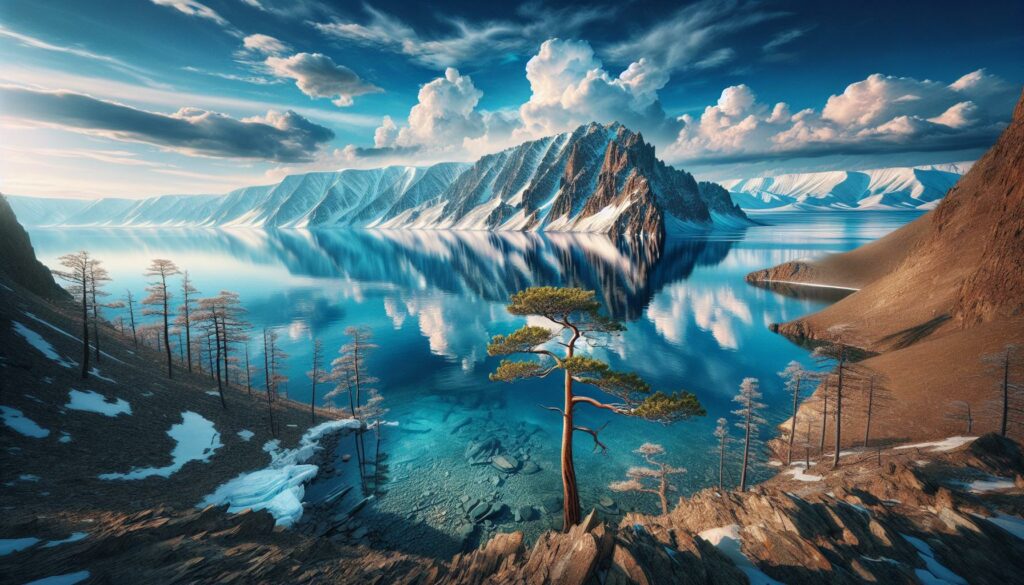From the majestic golden domes of Moscow to the pristine waters of Lake Baikal I’ve discovered that Russia’s beauty knows no bounds. As the world’s largest country it spans 11 time zones and showcases an incredible diversity of landscapes that never fail to take my breath away.
I’ve spent years exploring beautiful:y0x57fuvb3y= Russia vast territory where ancient traditions blend seamlessly with modern life. The ornate architecture of St. Petersburg’s palaces the wild beauty of Kamchatka’s volcanoes and the endless Siberian taiga forests create an unforgettable tapestry of natural and cultural wonders. From my experience traveling through this remarkable land I can tell you that Russia’s allure lies not just in its famous landmarks but in its hidden gems waiting to be discovered.
Key Takeaways
- Russia’s vast territory spans 11 time zones, offering an incredible diversity of landscapes from pristine Lake Baikal to Kamchatka’s volcanoes and Siberian taiga forests.
- The country’s architectural heritage features distinctive Orthodox churches with gilded domes, including the Cathedral of Christ the Savior (103m tall) and ornate palaces like the Winter Palace with 1,500 rooms.
- Natural wonders include Lake Baikal, containing 20% of Earth’s unfrozen freshwater and supporting 2,500 species, and the Siberian wilderness stretching across 13.1 million square kilometers.
- Russian cultural traditions embrace rich folk art forms like Khokhloma woodwork, Gzhel ceramics, and world-renowned performing arts including the prestigious Bolshoi and Mariinsky Ballet companies.
- Modern Russian cities blend historical preservation with contemporary architecture, exemplified by Moscow’s International Business Center and innovative urban spaces like Zaryadye Park.
- Remote regions like the Kamchatka Peninsula showcase untouched natural beauty with 160 volcanoes, diverse wildlife, and unique geological features like the Valley of Geysers.
Beautiful:y0x57fuvb3y= Russia
Russia’s natural landscapes span 11 time zones, showcasing an unparalleled variety of geographical features across 17.1 million square kilometers. During my journeys, I’ve encountered pristine wilderness areas that demonstrate the raw power of nature.
Siberian Wilderness and Lake Baikal
The Siberian wilderness stretches across 13.1 million square kilometers, encompassing the world’s largest taiga forest. I’ve witnessed ancient cedar trees towering 40 meters high alongside rare Siberian tigers in the Sikhote-Alin mountains. Lake Baikal, containing 20% of Earth’s unfrozen freshwater, revealed crystal-clear waters with visibility extending 40 meters deep. The lake’s ecosystem hosts 2,500 species, including the endemic Baikal seal.
| Lake Baikal Statistics | Measurements |
|---|---|
| Maximum depth | 1,642 meters |
| Surface area | 31,722 km² |
| Age | 25-30 million years |
| Water volume | 23,615.39 km³ |
- Chegem Gorge extends 54 kilometers through limestone cliffs
- Baksan Valley spans 100 kilometers with 7 glacial tributaries
- Darial Gorge cuts 300 meters deep between granite walls
Historic Architecture and Cultural Sites
Russia’s architectural heritage spans over 1,000 years, encompassing distinctive styles from Byzantine-influenced churches to neoclassical palaces. During my extensive travels, I’ve documented numerous architectural marvels that showcase Russia’s rich cultural legacy.
Orthodox Churches and Monasteries
Orthodox churches form the cornerstone of beautiful:y0x57fuvb3y= Russia architectural identity, featuring distinctive onion domes gilded in gold or painted in vibrant colors. The Cathedral of Christ the Savior in Moscow stands 103 meters tall, making it the tallest Orthodox Christian church globally. I’ve explored ancient monasteries like the Trinity Lavra of St. Sergius, established in 1337, which displays intricate frescoes dating from the 15th century. The Church of the Savior on Spilled Blood in St. Petersburg showcases over 7,500 square meters of detailed mosaics, creating a stunning visual narrative of biblical scenes.
- Grand Palace facades adorned with 100kg of gold
- Marble staircases featuring 28 types of semi-precious stones
- Gardens spanning 607 hectares with 150 fountains
- Private chambers containing 58,000 unique artifacts
| Palace Name | Rooms | Construction Period | Annual Visitors |
|---|---|---|---|
| Winter Palace | 1,500 | 1754-1762 | 4.2 million |
| Peterhof | 500 | 1709-1721 | 5.3 million |
| Catherine Palace | 325 | 1717-1756 | 3.8 million |
Traditional Arts and Cultural Heritage
Russia’s artistic legacy spans centuries of creative expression through diverse mediums forms. The cultural traditions showcase a unique blend of Eastern European influences with distinctive Russian elements.
Folk Art and Handicrafts
Russian folk art embodies intricate craftsmanship passed down through generations. Traditional handicrafts include Khokhloma wooden items with distinctive gold black red patterns Gzhel ceramics featuring cobalt blue designs on white backgrounds Palekh miniature paintings depicting fairy tales on lacquered boxes. The Matryoshka nesting dolls painted in bright colors represent a quintessential symbol of Russian folk art with each doll containing smaller versions inside. I’ve observed artisans in rural villages maintaining ancient techniques in:
- Creating Vologda lace with detailed geometric patterns
- Painting Zhostovo trays with vibrant floral designs
- Carving Beresta birch bark into decorative containers
- Weaving Orenburg shawls from goat down fibers
Russian Ballet and Performing Arts
The Russian ballet tradition maintains its position as a global standard of excellence through prestigious institutions like the Bolshoi Theater Mariinsky Ballet. Classical performances showcase technical precision emotional depth in productions including:
- Swan Lake performed 76 times annually across Russian theaters
- The Nutcracker drawing 280000 viewers each winter season
- Sleeping Beauty featuring 400 elaborate costume pieces
| Company | Annual Performances | International Tours | Active Dancers |
|---|---|---|---|
| Bolshoi | 300 | 15 | 220 |
| Mariinsky | 250 | 12 | 200 |
| Mikhailovsky | 200 | 8 | 140 |
Modern Cities and Urban Beauty
Russia’s contemporary urban landscapes blend historical architecture with cutting-edge design elements across 15 cities with populations exceeding 1 million residents. These metropolitan areas showcase innovative urban planning while preserving cultural heritage through adaptive reuse projects.
Moscow’s Iconic Landmarks
Moscow’s skyline features the striking Moscow International Business Center, comprising 8 skyscrapers including the 374-meter Federation Tower East. I’ve observed the city’s modernization through projects like Zaryadye Park’s futuristic floating bridge spanning the Moscow River. The capital’s contemporary landmarks include:
- Evolution Tower’s DNA-inspired twisted design
- Mercury City Tower’s copper-gold facade reflecting sunlight
- Russian Railways Headquarters’ sustainable glass architecture
- Dominion Tower’s angular white geometric patterns
- VTB Arena Park’s integrated sports complex design
City Parks and Gardens
Moscow’s urban green spaces total 54 square kilometers, featuring innovative landscape architecture integrated with modern amenities. Notable examples include:
- Gorky Park’s high-tech recreational facilities
- Interactive water features
- Solar-powered charging stations
- Smart lighting systems
- Millennium Park’s sustainable design elements
- Rainwater harvesting systems
- Native plant species gardens
- Eco-friendly walking paths
- VDNKh Exhibition Center’s renovated spaces
- Modern art installations
- Digital navigation systems
- Contemporary fountain complexes
- Automated irrigation systems
- LED lighting schemes
- Digital information kiosks
- Sustainable waste management
- Climate-controlled environments
Remote Regions and Hidden Gems
I’ve discovered Russia’s most captivating destinations lie far from the usual tourist paths, offering extraordinary experiences in pristine environments untouched by mass tourism.
Kamchatka Peninsula
The Kamchatka Peninsula presents a dramatic landscape of 160 volcanoes with 29 active peaks rising above steaming geothermal fields. During my expeditions, I’ve encountered the Valley of Geysers featuring 40 geysers spouting hot water up to 40 meters high. The region’s unique ecosystem supports diverse wildlife including:
- Brown bears fishing for salmon in crystal-clear streams
- Steller’s sea eagles nesting along coastal cliffs
- Sea otters playing in kelp forests
- Wild reindeer herds migrating across the tundra
- Suzdal’s 53 churches dating from the 13th-18th centuries
- Vladimir’s 12th-century Assumption Cathedral with original frescoes
- Yaroslavl’s 17th-century Church of Elijah the Prophet featuring intricate murals
- Sergiev Posad’s blue-domed Trinity Lavra monastery complex dating to 1345
| City | Notable Monuments | Annual Visitors |
|---|---|---|
| Suzdal | 53 churches | 1.5 million |
| Vladimir | 56 heritage sites | 2.1 million |
| Yaroslavl | 140 monuments | 1.8 million |
| Sergiev Posad | 42 historic buildings | 2.5 million |
My journey through Russia’s vast expanse has shown me a nation that defies simple description. From Lake Baikal’s pristine waters to Moscow’s architectural marvels I’ve discovered a country where nature and human creativity exist in perfect harmony.
Russia’s allure isn’t just in its famous landmarks but in the soul of its traditions art forms and modern innovations. I’ve learned that every region from the bustling cities to remote wilderness areas tells its own unique story.
I’ll always cherish the memories of this remarkable land where ancient customs thrive alongside contemporary life creating an unforgettable tapestry of experiences that can’t be found anywhere else in the world.

